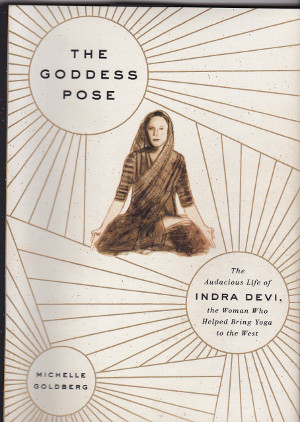Book Review - The Goddess Pose|
Michelle Goldberg
(Knopf 323pp)
With yoga’s booming popularity in the West, increased interest is being shown in the practice’s history. A key figure was Paramahansa Yogananda, whose memoir Autobiography of a Yogi was a cult classic in the 1970s. He is now the subject of a new documentary, Awake, doing the rounds of Australian cinemas.
Less well known is the subject of this book, Indra Devi, born (in 1899) as Eugenia Vassilievna into minor aristocracy in pre-revolutionary Russia. Her “audacious life”, as the sub-title puts it, spanned the major war zones of the twentieth century and encompassed ballet and cabaret dancing, Indian films, European politics, the diplomatic world, spiritualism, and finally, yoga.
A ceaseless traveller, often by necessity, she lived in eastern and western Europe, and China, but was most enamoured of India where the Theosophist movement had established a community centred on their poster boy, Krishnamurti, of around Eugenia’s age.
While yoga was not central to the group’s interests, it intrigued many of them and it was here that the glamorous White Russian first came into contact with the practice that would dominate her life.
Amongst those she would meet in then-British India were Mahatma Gandhi and his secular comrade, Jawaharlal Nehru, a one-time Theosophist who had ditched his mysticism and turned to anti-imperialism. He would go on to become the first prime minister of independent India (and father Indira Gandhi).
Meeting Nehru at a dinner, she asked how he managed to survive his many stays in British prisons.
“He told her that, more than anything, what had saved him when he was locked up was yoga.”
Later, married to a Czech diplomat in Bombay, Eugenia could observe how “hatha yoga’s reputation was being transformed… into a wholesome indigenous science of health and longevity… (she) would find herself right at the center of the hatha yoga renaissance.”
As the author adds, “It is true that Indians have been doing yoga for millennia, but their practices didn’t necessarily have anything in common with yoga as currently understood by the West, as a series of poses and breathing exercises designed to strengthen the body and calm the mind… modern yoga is a hybrid of ancient and contemporary ideas, an East-West fusion.”
A cultural fusion herself, Eugenia - who also used the name Jane Peterson, after her father - liked what she saw, although the barriers for a woman, especially a foreigner, were immense. Her first training was with an instructor responsible for training wrestlers, a regime that combined pushups with a flowing series of lunges that, as the author notes, “today form an essential part of modern hatha yoga classes.”
Her resolve would bring her to the feet of Krishnamacharya, an iron disciplinarian whose suffering pupils would include BKS Iyengar, later “the most celebrated yoga teacher in the world.” He died recently at 95.
In time, her physical and mental barriers dissolved, she lost weight, her skin became radiant, and she felt “as light and carefree as a school girl on a summer vacation.”
After eight months, the guru came to both accept her and believe that yoga should be spread worldwide.
“Now that you are going to visit other countries in the world,” he told her, “I want you to teach yoga.”
Although terrified, she assembled her notebooks on poses, diet, relaxation, and meditation, and still unsure that she would ever get students, set forth again, this time to war torn Shanghai where her Czech husband was a diplomat from a government that had ceased to exist.
After the war she returned to India, now decolonizing, and after a brief trip to China, bought a ticket to the USA where the final act in her amazing life would unfold. Changing her name to Indra Devi, and befriended by America’s glamorous elite, including makeup czar Elizabeth Arden, and actors such as Greta Garbo and Gloria Swanson, she established yoga studios, penned a best seller Forever Young, Forever Healthy, and rode the emerging yoga wave to its Californian peak, which continues today.
Devi never pretended to be perfect, but seems to have had a weakness for those who claimed they were, most embarrassingly Sathya Sai Baba, an afro-haired guru who attracted millions (of followers and dollars) before being accused of sexual impropriety and fraudulence.
“Indra Devi’s spirit animates modern Western yoga… [even if] There is an immense gulf between the limber young women in Lululemon yoga gear rolling out rubber mats on the hardwood floors of modern studios and the ash-smeared half-naked yogins who contort theselves on the banks of the Ganges.”
Eugenia Vassilievna/Jane Peterson/Indra Devi died in 2002 at the age of 102, having seen the end of the 19th century, all of the 20th, the start of the 21st, and the entrenchment of yoga as one of the most popular pastimes ever to go West.
















